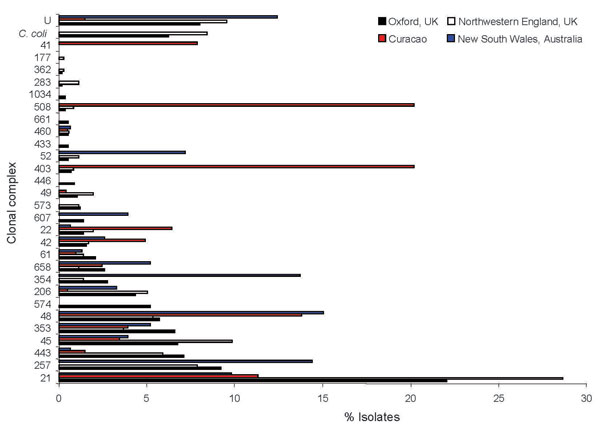Volume 14, Number 10—October 2008
Dispatch
Extended Sequence Typing of Campylobacter spp., United Kingdom
Figure 1

Figure 1. Relative abundance of clonal complexes of Campylobacter spp. detected in Oxfordshire, United Kingdom, during a 1-year study compared with clonal complexes detected in 3 other studies of human Campylobacter spp. infections in northwestern England (7), New South Wales, Australia (8), and Curaçao (9).
References
- Humphrey T, O’Brien S, Madsen M. Campylobacters as zoonotic pathogens: a food production perspective. Int J Food Microbiol. 2007;117:237–57. DOIPubMedGoogle Scholar
- Dingle KE, Colles FM, Wareing DRA, Ure R, Fox AJ, Bolton FJ, Multilocus sequence typing system for Campylobacter jejuni. J Clin Microbiol. 2001;39:14–23. DOIPubMedGoogle Scholar
- Dingle KE, Colles FM, Ure R, Wagenaar J, Duim B, Bolton FJ, Molecular characterization of Campylobacter jejuni clones: a rational basis for epidemiological investigations. Emerg Infect Dis. 2002;8:949–55.PubMedGoogle Scholar
- Sails AD, Swaminathan B, Fields PI. Utility of multilocus sequence typing as an epidemiological tool for investigation of outbreaks of gastroenteritis caused by Campylobacter jejuni. J Clin Microbiol. 2003;41:4733–9. DOIPubMedGoogle Scholar
- Meinersmann RJ, Helsel LO, Fields PI, Hiett KL. Discrimination of Campylobacter jejuni isolates by fla gene sequencing. J Clin Microbiol. 1997;35:2810–4.PubMedGoogle Scholar
- Mellmann A, Mosters J, Bartelt E, Roggentin P, Ammon A, Friedrich AW, Sequence-based typing of flaB is a more stable screening tool than typing of flaA for monitoring of Campylobacter populations. J Clin Microbiol. 2004;42:4840–2. DOIPubMedGoogle Scholar
- Sopwith W, Birtles A, Matthews M, Fox A, Gee S, Painter M, Campylobacter jejuni multilocus sequence types in humans, northwest England, 2003–2004. Emerg Infect Dis. 2006;12:1500–7.PubMedGoogle Scholar
- Mickan L, Doyle R, Valcanis M, Dingle KE, Unicomb L, Lanser J. Multilocus sequence typing of Campylobacter jejuni isolates from New South Wales, Australia. J Appl Microbiol. 2007;102:144–52. DOIPubMedGoogle Scholar
- Duim B, Godschalk PC, van den Braak N, Dingle KE, Dijkstra JR, Leyde E, Molecular evidence for dissemination of unique Campylobacter jejuni clones in Curacao, Netherlands Antilles. J Clin Microbiol. 2003;41:5593–7. DOIPubMedGoogle Scholar
- Hunter PR, Gaston MA. Numerical index of discriminatory ability of typing systems: an application of Simpson’s index of diversity. J Clin Microbiol. 1988;26:2465–6.PubMedGoogle Scholar
- Huang S, Luangtongkum T, Morishita TY, Zhang Q. Molecular typing of Campylobacter strains using the cmp gene encoding the major outer membrane protein. Foodborne Pathog Dis. 2005;2:12–23. DOIPubMedGoogle Scholar
- Schouls LM, Reulen S, Duim B, Wagenaar JA, Willems RJ, Dingle KE, Comparative genotyping of Campylobacter jejuni by amplified fragment length polymorphism, multilocus sequence typing, and short repeat sequencing: strain diversity, host range, and recombination. J Clin Microbiol. 2003;41:15–26. DOIPubMedGoogle Scholar
- Thakur S, Morrow WE, Funk JA, Bahnson PB, Gebreyes WA. Molecular epidemiologic investigation of Campylobacter coli in swine production systems, using multilocus sequence typing. Appl Environ Microbiol. 2006;72:5666–9. DOIPubMedGoogle Scholar
- Pebody RG, Ryan MJ, Wall PG. Outbreaks of campylobacter infection: rare events for a common pathogen. Commun Dis Rep CDR Rev. 1997;7:R33–7.PubMedGoogle Scholar
- McCarthy ND, Colles FM, Dingle KE, Bagnall MC, Manning G, Maiden MC, Host-associated genetic import in Campylobacter jejuni. Emerg Infect Dis. 2007;13:267–72.PubMedGoogle Scholar
Page created: July 13, 2010
Page updated: July 13, 2010
Page reviewed: July 13, 2010
The conclusions, findings, and opinions expressed by authors contributing to this journal do not necessarily reflect the official position of the U.S. Department of Health and Human Services, the Public Health Service, the Centers for Disease Control and Prevention, or the authors' affiliated institutions. Use of trade names is for identification only and does not imply endorsement by any of the groups named above.